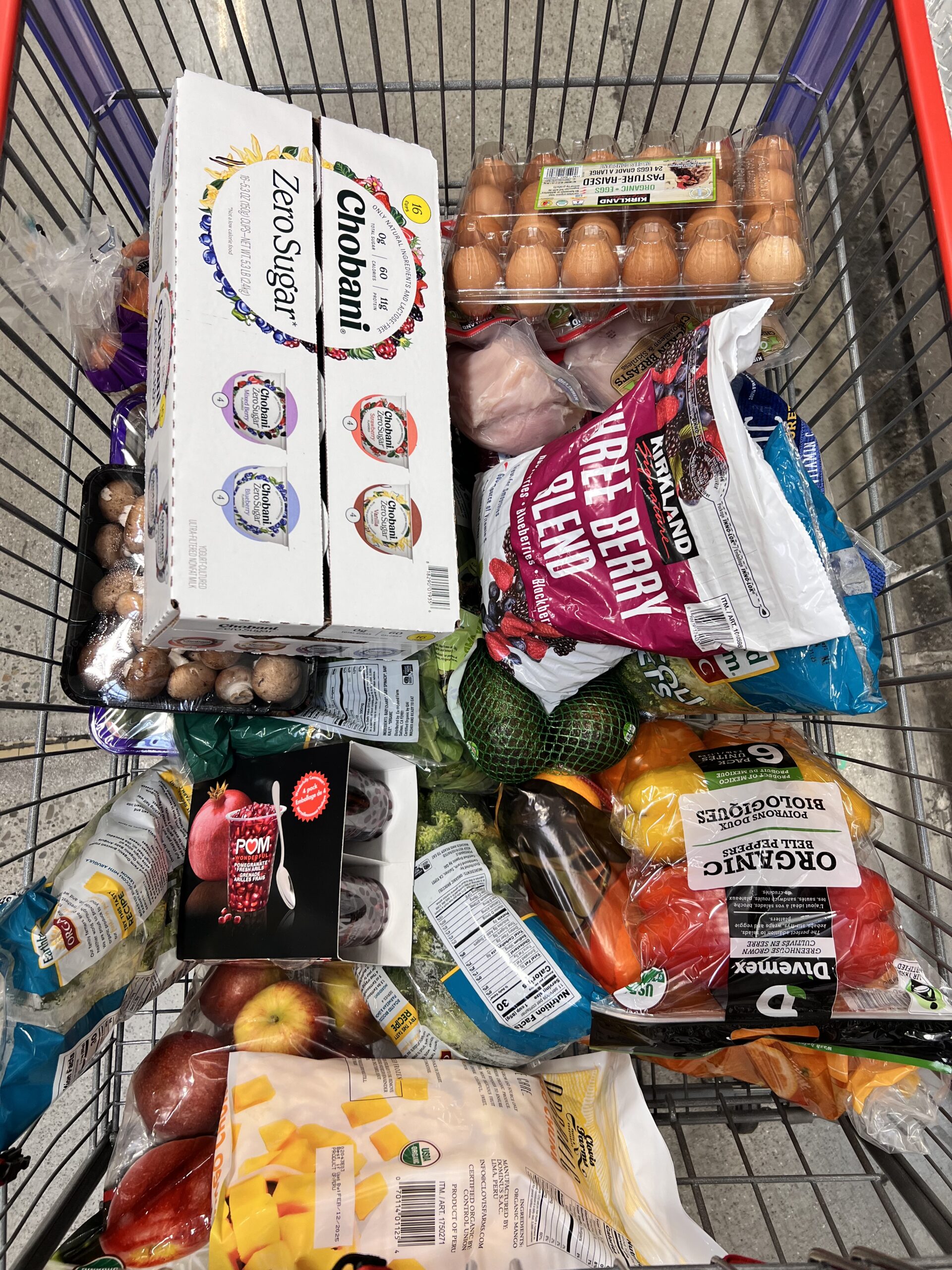Tips for Improving Your Relationship with Food and Grocery Stores (Building an Eating Strategy)
Eating for your optimal health:
The way we relate to food can determine much of our eating habits and strategies. If we understand food as fuel, and how everything within our bodies is made from the breakdown of this food, you might change the way you eat. If we have certain health goals in mind, our eating strategy should reflect those goals. We look to food for so many reasons. This includes energy boosts, inflammation reduction, digestive stimulation, detoxification support, building blocks for tissues, bones, and organs, reproductive health, and cognitive support.
The QUALITY of our diet should be the priority when fueling for everyday life. The foods we eat directly influence the function of every organ system, and can either optimize the function or cause malfunction over time. Prioritizing foods based on their nutritional content, like vitamins, minerals, phytochemicals, polyphenols, antioxidants, amino acid profiles, and fatty acid types will provide the necessary nutrients for our physiology.
Then we must consider eating strategy and dietary priorities. Most of us know or have heard about macros, but we also need to be cognizant of nutritional variety. Eating a wide variety of fruits, vegetables, grains, and proteins provides a wide variety of antioxidants, vitamins, fiber types, minerals, phytonutrients, and amino acids. A balanced eating strategy involves thinking about both our macronutrient and micronutrient intake from our foods. Just as Dr. Mark Hyman, one of the founding physicians of functional medicine, once said,” Food is medicine, if you allow it to be.” We should eat for nutrients, recovery, sustenance, and performance rather than satiation, enjoyment, comfort, or defiance. Eating with a clear strategy and goal in mind can help to keep you on track even when motivation runs out.
We learn how to approach food the same way we learn anything else – through those in our direct environment. It’s subconscious, but as we develop, we learn what our relationship with food should look like from our parents, friends, family members, and community members (Hardcastle et al, 2015). If there are patterns of emotional eating, binging, comfort eating, or other maladaptive eating habits, it is more likely for others in the environment to also model these coping strategies.
It might not always be entirely negative. Some eat out of boredom, some find comfort in certain foods because of positive memory associations, and some might look forward to specific seasons or holidays because of the gatherings centered around food (Hardcastle et al, 2015). It is important to understand our reason for eating and become more conscious of our eating habits so we can create actionable changes towards our previously set goals.
Common Reasons for Straying Away from our Eating Strategy: (psychological/mental/emotional)
- Planning and Reality are not aligned
In theory, eating well and planning our meals sounds simple. Buy groceries, plan out meals, prep in advance (maybe?), then finish preparing the meal and eat. Easy enough, right? But interruptions, delays, and stress that might steer us away from our planned eating strategy are hard to plan for. Even if everything goes well throughout the day, fatigue and unexpected circumstances can often influence our eating strategy over time.
- Stress/Emotional Overload
Stress is one of the most common influences on eating pattern changes and can influence our in-the-moment decisions when choosing our meals. Oftentimes, these meals are generally centered around foods that bring us joy, comfort, or satisfaction when we are experiencing intense negative emotions. Emotional eating is most commonly associated with feelings of stress, frustration, anxiety, depression, loneliness, and sadness (Betancourt-Nunez et al, 2022). As many as 49% of adults in the United States report emotionally eating on a weekly basis according to a survey conducted by the American Psychological Association (APA) (Dakanalis et al, 2023). Research shows that emotional eating generally happens when heightened sensations happen in the body due to emotional overwhelm or stress, and to some, it can mimic hunger symptoms (Betancourt-Nunez et al, 2022; Dakanalis et al, 2023). Others, food can be a point of comfort and safety, especially for those who don’t have a lot of control over their daily lives (thus the food represents something they CAN control).
- Community/Household Influences
Often, our environment has an outsized impact on our eating habits. When our household or community lacks an eating strategy plan, we can feel derailed and thrown off. If our partner or spouse does not understand our goals or does not want to actively participate in our health and wellness journey, it can be a point of tension in a relationship. Those who are pursuing a lifestyle change to address their health are more successful when their partners actively support them in this process (Gettens et al, 2018).
- Lack of willpower in sticking to goals
When motivation runs out, discipline takes over. Some start strong out of the gate because change is exciting and new plans can be incredibly motivating. Others are intimidated but show the discipline to push themselves through uncomfortable situations. The source of motivation can be highly influential on your discipline throughout a transition and can be a predictor of the success of a specific change. Extrinsic motivation is reliant on something within your environment to trigger a response for change, and intrinsic motivation comes from a place of self-awareness and self-care. When we want to do right by ourselves, the effort is more meaningful and impactful. Intrinsic motivation is also more successful.
- Dysfunctional relationship with food (modeled by parents or family members while growing up)
Just like all other behaviors, we observe actions that we deem appropriate and adopt them for ourselves. As children, our parents, friends, and family members are the main source of these behaviors, and can set the tone for the rest of your life (if they’re not addressed or consciously questioned) (Hardcastle et al, 2015). For many, eating behavior is adopted into practice by the observer, which can help in identifying the origin of specific eating tendencies.
For example, my dad grew up in a house with all brothers. At dinner time, whoever could grab their food first and eat it as fast as possible was usually the one to get seconds (as there was usually no food left after the lucky person gets their second helping), so he modeled hurried, frantic eating habits. Moreover, my mom (sorry mom!) would come home and indulge in sweets when she had a really stressful day.
- Hormonal imbalances (diabetes, metabolic syndrome, stress, menstrual cycle influence, etc)
Certain hormonal conditions can affect the body’s ability to communicate with itself, especially when it comes to hunger and satiety. Dysfunction in the main processing center (hypothalamic-pituitary adrenal axis (HPA)) can disrupt the hunger and satiety hormones leptin and ghrelin (Chao et al, 2017). This can lead to overeating, increased snacking, guilt around food, and altered decision-making skills.
Diabetes is a metabolic disorder where the function of the pancreas (the organ responsible for digestive enzyme and insulin production) does not function properly and has limited communication abilities with the rest of the body. Metabolic syndrome, an increasingly common diagnosis in the United States, is the beginnings of diabetes caused by eating habits, stress altering hormone pathways, or hormonal imbalances lending to decreased insulin sensitivity like PCOS and endometriosis.
Stress alone can affect our insulin sensitivity and cellular insulin resistance throughout the body, and even one night of sleep deprivation can mimic pre-diabetic levels of insulin resistance (hence why you might be hungrier the day following a horrible night of sleep) (Chao et al, 2017). Thus, stress management strategies can be a multi-factorial solution for lifestyle change.

- Serving Size (amount of food that contribute to the daily values in the chart)
- Servings per container – important to pay attention to caloric density (eg. 500 calories in 3 cups vs. 500 calories in ½ cup)
- Total Carbohydrates (net carb = total carb – fiber)
- Micronutrient and fiber profile of food – like vitamins and minerals found in the food
- Total calories and daily value per nutrient in one serving
Become familiar with food labels, as the understanding and comprehension of these data are generally associated with healthier individuals (Hardcastle et al, 2015). Pay attention to serving sizes and the percent daily value calculation – these proportions are based on 2,000 calories per day. If you are eating more or less than 2,000 calories per day, you then have to adjust your values accordingly.
In a literature review, researchers found that people who regularly cook and experiment with food tend to have healthier eating habits, and cooking classes can actually help to improve both your relationship with food and your eating habits (Hardcastle et al, 2015). Use this to set a good example for those who are watching your behavior. As we now know, observation is a powerful influence on our habits!
Using a clearly defined strategy
Shopping for food can be a daunting task. Last-minute-grab sugar shelves, a plethora of different options for each product or ingredient, and the prioritization of processed food advertisements stand in our way. On top of this, junk food is often more affordable than healthy options. Here are a few ways to strategize your grocery shopping so you can stock your pantry with all the essentials.

First, always write the list. This list can be based on recently found recipes you’d like to try, old staples you love cooking that double as great leftovers for meal prep, or essential supplies to stock the pantry for quick, simple meals. Make sure to be specific about quantity and think ahead at the week’s plan – what time have you allotted for meal time and meal prep? Are there any nights where a pre-planned meal would be beneficial? What staples can I keep on hand that can be used in a wide variety of meals and dishes?
Additionally, this list can serve as a checkpoint for the most impulsive food decisions, like sweets, cravings, tempting deals on low-quality foods, and processed snacks. Be intentional with this list.
Second, purchase shelf-stable items ahead of time so you have options for quick meals at home, like your favorite healthy pasta option (Banza bean pasta or Trader Joe’s brown rice and quinoa pasta are great choices), rice and grains, canned vegetables and fruits, sauces, coconut milk, frozen fruit, nuts and seeds, dried goods, and spices. These ingredients can be made into a wide variety of dishes that can be made relatively quickly. Buy meat in bulk and freeze, then take it out to defrost on meal prep or cooking days.
For example, we keep one jar of pasta sauce or simmer sauce, one type of pasta, at least one type of grain, dried beans, commonly used canned ingredients (like coconut milk, diced tomatoes, tomato paste, enchilada sauce, etc), and salad dressings/oils/toppings backstocked in our pantry because this gives us options throughout the week depending on our schedule and energy availability for cooking.
Third, buy produce right before you use it. It’s one of the only foods where you do not get a discount with bulk purchase, and it is usually the most likely to be thrown out due to its limited shelf life and time-sensitive nature. When you purchase produce on the day (or maybe the day before) you plan to use it, it ensures fresher ingredients and less waste. But, don’t forget about our first strategy… (aka, don’t forget to write that list, even for produce).
Tips for Successful Grocery Shopping (Dakanalis et al, 2023)
- Your shopping cart should resemble your eating strategy – dense in a variety of produce, minimal items that come from a box or bag
- Buy products with less than ~10 ingredients (all of which you can pronounce)
- Plan basic meals that you can adjust on the fly – keep foundational items around and get creative ways to add variety to these foundational items
- Find healthy replacements for your go-to snacks
- Eat before going to the grocery store
Make it REALISTIC, and remember our rule: stick to the list!
Sign up for FiT’s Health Optimization and Wellness Blog
![]() 600 Rancho Shopping Center, Los Altos CA 94024. | 650-947-9831
600 Rancho Shopping Center, Los Altos CA 94024. | 650-947-9831
Get Directions | Email Us | Jobs | Follow us:
Sign up for FiT’s Health Optimization and Wellness Blog
![]() 600 Rancho Shopping Center, Los Altos CA 94024. | 650-947-9831
600 Rancho Shopping Center, Los Altos CA 94024. | 650-947-9831
Get Directions | Email Us | Jobs | Follow us:
Kristin Pampeyan
Trainer
Spirit Animal: Bumblebee
What I love about FiT: That everyone is invested in the community whether it’s by hosting additional activities or sharing knowledge. It’s all to make each other better and help out the clients.
Favorite sports: Swimming and Softball

Dae-Von Bishop
All the way from East Palo Alto, Dae-Von was an avid basketball player and fan since the age of 10. From Eastside College Prep to Sonoma State to Foothill where he received his AA in psychology. Dae-Von developed a passion for training and helping others stay active and healthy after a bad ankle sprain in high school that occurred during the basketball season. Dae-Von received training the following summer at The Riekes Center, leading him to have a healthy senior year season as well as making 2nd team all league.This is what inspired him to become a trainer and help other athletes stay in great shape. At 20 years old, Dae-Von’s personal training journey began at The Riekes Center, and he hasn’t looked back since.
Dae-Von holds certifications in personal training through NASM, archery, as well as speed and agility and weightlifting both through NSPA. He even will do some basketball skill development on the side for young hoopers. His goal is to help people stay as fit and active as possible with little to no complications. I love training groups of athletes in either middle or high school. Those age groups tend to be the best time for athletes to get faster and stronger, as well as they begin to understand movement patterns which allow them to perform at an elite level. There is also a natural competitive aspect of training in groups that pushes kids to go harder during drills.
In his free time, you can find Dae-Von shooting hoops, working out, playing video games, spending time with friends, trying new foods(as long as there is no avocado), or hanging out with his frenchie, Trouble.
- Personal Trainer (NASM)
- Certified Speed and Agility Coach (National Sports Performance Association)
- Certified Weightlifting Coach (National Sports Performance Association)
- Archery Lvl. 2 (USA Archery)

Megan Justice

Jon Angeles

James Frederick
Trainer
Spirit Animal: Orca
Contact
- Dynamic Variable Resistance Training (DVRT) Level 1 Certification
- Certificate in Nutrition (FAB Academy)
- Certificate in Applied Stretching Theory and Practice (FTP)
- NASM-CPT

Jake Verhulp

Hannah Golden

Serena Earwicker
Operations Manager
Spirit Animal: Owl
Contact
Serena manages the day-to-day operations at FIT. If you need help with something apart from training, she is the one to get it done.
Outside of FIT you will find Serena hiking, biking and playing at the beach with her family.
What I love about FiT: FiT is welcoming and supportive to all. It feels like a hug, a sweaty one. Haha
Favorite sports: Anything I get to see live! Love the energy.

Tracey Downing
Owner
Spirit Animal: Owl
Contact
Tracey Downing has dedicated her life’s journey to empowering individuals to discover newfound confidence in their physical abilities and take command of their long-term well-being. Together with her husband, Thom, she established FiT, a health promotion company, in 2000, impacting numerous lives by guiding them towards positive lifestyle shifts and instilling the importance of prioritizing their health.
Her academic journey at the University of Michigan, where she graduated with a degree in Kinesiology, was complemented by a vibrant period of exploration. Tracey’s adventures took her across the globe to live in places like New Zealand, Ireland, and Scotland. These enriching experiences allowed her to indulge her passion for travel while simultaneously nurturing her professional growth, with roles in clinical and professional sports settings.
Beyond her entrepreneurial pursuits, Tracey treasures her role as a mother to two wonderful children. Outside of her business endeavors, she has completed an Ironman Triathlete, a testament to her unwavering determination, had the incredible honor of being an Olympic Torch Bearer for the Salt Lake City Olympics, and is a 20 year survivor of breast cancer.
In Tracey’s world, fostering physical wellness is not just a profession; it’s a lifelong vocation driven by a genuine desire to inspire and uplift others on their unique journeys toward lasting health and vitality.
What I love about FiT: Seeing people change: doing more than they thought they could, learning more than they thought they would, and showing up to make themselves better.
Favorite sports: Playing tennis and watching anything my kids are playing

Brett Lando
Physical Therapist
Spirit Animal: Cheetah
Contact
Brett grew up in San Francisco and attended St. Ignatius College Preparatory where he ran cross-country and track and field. After graduating from high school, he attended the University of California, Irvine where he earned his Bachelor’s degree in Biology. While at UC Irvine he competed on the cycling team in road and cyclo-cross races and helped manage the campus bike shop.
Brett graduated with his Doctorate of Physical Therapy from the University of California San Francisco/San Francisco State University. He is a graduate of Agile’s yearlong Orthopedic Residency, is a Board Certified Orthopedic Clinical Specialist and most recently completed a yearlong Fellowship in sports and manual therapy.
In his free time, Brett enjoys road cycling, the occasional triathlon, alpine skiing, surfing, backpacking, traveling and cooking with his wife.
What I love about FiT: The TEAM, Learning new exercises from the trainers, and a variety of fun, innovative exercise equipment.
Favorite sports: Cycling, Skiing, Surfing
- Doctor of Physical Therapy
- Board- Certified Clinical Specialist in Orthopaedic Physical Therapy
- Fellow of the American Academy of Orthopaedic Manual Physical Therapists

Kendra Wagers
Massage Therapist
Contact
Kendra Wagers has been a Massage Therapist since 2001. A native to California, she began her massage career in the Central valley working with various injury and chronic pain methods under experienced Chiropractors and physical therapists. In 2003 she relocated to Las Vegas, NV to attend the Nevada School of Massage Therapy’s accredited massage program which led to obtaining her National certification from NCBTMB. For over 13 years she worked as a licensed massage therapist in Nevada, including employment at top rated Spas on the Las Vegas strip. Receiving training in various modalities over the years including; Hawaiian Lomilomi, Thai, Sports and Shiatsu. In January of 2017 Kendra decided to return to California and is currently enrolled in the Traditional Chinese Medicine program at Five Branches University, furthering her education on overall health and wellness. With more than 17 years of experience and over 1500 hours in training Kendra has been able to hone in on her passion for healing while combining multiple techniques to provide a personalized and detailed massage to every guest. Her serene approach combined with her roots in structural techniques, offers harmony, balance, and ease to injuries or everyday stresses.
CA State Massage License #73011

Katie Deangelis
- American Council on Exercise
- Crossfit Level One
- NSCA Certified Strength and Conditioning Specialist, In Progress
- Precision Nutrition Level 1 Certified, In Progress

Kevin Martin
Strength and Wellness Coach
Personal Trainer
Certified Strength and Conditioning Specialist
OPEX CCP
Spirit Animal: The Lorax
Contact
Kevin graduated from Trinity University in San Antonio, TX with a B.S. in Business Administration with a focus in marketing. As a student, Kevin was a five-time conference champion in the 1-meter and 3-meter springboard diving events. He is a Certified Strength and Conditioning Specialist with the National Strength and Conditioning Association.
He has a particular passion for rehabilitation and improving overall functional status. He enjoys identifying and correcting areas of the body that are not operating at their full potential so that everyone can live life to the fullest!
Kevin has completed a full ironman, multiple 70.3 triathlons, 2 full marathons, as well as several shorter distance triathlons and road races. In addition to triathlon, he has a background in gymnastics, swimming, diving, and volleyball. He enjoys helping everyone find the athlete within themselves and find a love for movement and exercise.
When Kevin isn’t training at FiT or exercising, he enjoys cooking, surfing, hiking, and spending time with his wife and dog. He especially loves being a father his young daughter Mayley.
What I love about FiT: Community, Hard work, Supportive, Fun
Favorite sport: Volleyball, Surfing, Diving, Running, Cycling, Swimming (triathlon), Weight lifting. I love watching all sports.

Tyler Pinkney
- 4 years of collegiate coaching experience
- Former Division I Athlete
- Assisted multiple athletes to the professional level
- Certified Strength and Conditioning Specialist, National Strength and
- Conditioning Association
- Basic Olympic Lifting Certification, Totten Training Systems
- Bachelors of Science in Psychology
- Masters of Education in Coaching, Sport, Recreation, and Fitness
- Administration

Juliana Oliveira
Trainer
Spirit Animal: Dolphin
Contact
What I love about FiT: I love the schedule flexibility.
Favorite sports: Snorkeling and swimming

Angelo de la Cruz
Orthopedic Massage Therapist & Personal Trainer
Spirit Animal: Wolf-bear-dragon-unicorn beast
Contact
While studying biological sciences at Cal Poly SLO, it became clear that my health was suffering. I was always tired, I couldn’t sleep well, I had digestive issues, and my emotions would swing dramatically at times. The realization came that in order for me to enjoy life to its fullest, I had to get serious about improving the quality of my health.
Since then, I’ve studied with doctors, physical therapists, clinical nutritionists, physical trainers, bodyworkers, and top innovators in the field of health & wellness. Instead of chasing the symptoms of illness, the most effective approaches to well-being are those that work to eliminate things that degrade health AND instill lifestyle habits that allow the natural environment of our bodies and mind to operate as efficiently as possible. In this way, we can be lead lives with less pain & sickness.
My work aims to use the technology of the body to help you live a more vibrant & productive life.
Some of the things I have fun doing are Olympic Weightlifting, breakdancing, parkour & free-running, snowboarding, creating electronic music, digital art photography/ videography, competing in American Ninja Warrior (My competition run is here) & learning about quantum physics.
What I love about FiT: Uplifting, motivating, supportive
Favorite sport: Martial Arts, ninja warrior obstacle courses, break dancing
- Former Life Science Support Scientist at NASA Ames Research Center
- Certified High Performance Coach
- 2nd Degree Black Belt in Taekwondo
- CrossFit – Level 1 Certification
- USA Weightlifting Club Coach Certification
- Intrinsic Coach Certification – Life & Health Coaching
- BS Anatomy & Physiology
- American Massage Therapy Association – Professional Member
- Nationally Certified in Therapeutic Massage & Bodywork
- Certified Hendrickson Method Instructor
- Primal Reflex Release Instructor
- Certified Massage Therapist
- Certified Functional Diagnostic Nutrition Practitioner

Shaun Conness
- USAW Club Coach
- NASM Certified Trainer
- TPI Golf Fitness Instructor
- CHEK Practitioner Level 1
- CHEK Certified Golf Biomechanics Specialist

Jennifer Mulry
Personal Trainer
Spirit Animal: Bear
Contact
What I love about FiT: I love the family atmosphere at FiT and the collective effort to all be the healthiest version of ourselves.
Favorite Sport(s): Basketball & Swimming

Jeff Samson
Trainer
Martial Arts Trainer
Assisted Stretch Practitioner
Spirit Animal: Blue Whale
Contact
What I love about FiT: Great space, staff, clients, ability to pursue my passions
Favorite sport: Jiujitsu


